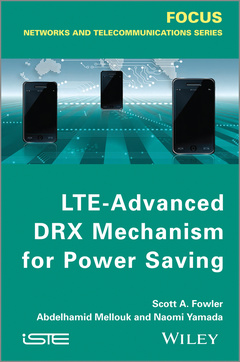Description
LTE-Advanced DRX Mechanism for Power Saving
Authors: Fowler Scott A., Mellouk Abdelhamid, Yamada Naomi
Language: English
Subject for LTE-Advanced DRX Mechanism for Power Saving:
171.59 €
In Print (Delivery period: 14 days).
Add to cart128 p. · 16x24.1 cm · Hardback
Description
/li>Contents
/li>Biography
/li>
By introducing the basics of mathematical analysis and performance evaluation of power-saving mechanisms in 3rd generation partnership project (3GPP) LTE and LTE-Advanced networks, the authors of this book aim to describe novel algorithms which could have better performance capabilities than previous methods.
Chapter 1 gives the basic theory description of the 3GPP LTE network and 3GPP DRX power saving mechanism, empirical measurements of LTE network traffic and an overview of the basic LTE DRX model in the field of power saving techniques. Chapter 2 provides steps for deriving a 2-state analytical model up to a 4-state DRX model. The third and final chapter summarizes alternative methods for the implementation of LTE DRX.
Contents
1. Basic Theory.
2. Analytical Semi-Markov Power-Saving Models.
3. Other Approaches for LTE Power Saving.
About the Authors
Scott A. Fowler is Associate Professor at Linköping University, Sweden, working with the Mobile Telecommunication (MT) group. He has served on several IEEE conferences/workshops as TPC to Chair, including Special Interest Groups coordinator for IEEE Communications Software (CommSoft) Technical Committee since 2012. His research interests include Quality of Service (QoS) support over heterogeneous networks, computer networks (wired, wireless), energy management, mobile computing, pervasive/ubiquitous, performance evaluation of networks and security.
Abdelhamid Mellouk is Full Professor at the University of Paris-Est Créteil VdM (UPEC, ex. Paris 12), Networks & Telecommunications (N&T) Department (IUT C/V) and LiSSi Laboratory in France. He is a founder of the Network Control Research activity with extensive international academic and industrial collaborations. His general area of research is in adaptive real-time control for high-speed new generation dynamic wired/wireless networking in order to maintain acceptable Quality of Service/Experience for added-value services.
Naomi Yamada is a research associate at Linköping University, Sweden.
PREFACE ix
INTRODUCTION xi
CHAPTER 1. BASIC THEORY 1
1.1. LTE overview 2
1.2. Scheduling in LTE 5
1.2.1. Quality of Service parameters 6
1.2.2. Channel quality indicator 8
1.2.3. Buffer state and resource allocation history 10
1.3. LTE Traffic measurements 11
1.3.1. Testing environment 12
1.3.2. VoIP preliminary capacity 13
1.3.3. Video conversation preliminary capacity 14
1.3.4. Post video and live video preliminary capacity 15
1.3.5. Summary on the LTE Traffic measurements 18
1.4. User equipment power saving in LTE 18
1.4.1. DRX cycle 18
1.5. Models for LTE Power Saving 24
1.5.1. 3GPP power consumption model 25
1.5.2. Characteristics of NokiaTM power consumption model 26
1.6. Conclusion 29
1.7. Bibliography 30
CHAPTER 2. ANALYTICAL SEMI-MARKOV POWER-SAVING MODELS 33
2.1. Introduction of bursty packet data traffic 33
2.2. Designing a simple Two-state DRX model using semi-Markov 36
2.2.1. State 1 to state 1 and state 1 to state 2 38
2.2.2. Transition probability matrix 39
2.2.3. How we obtain equation [2.4] 39
2.2.4. Holding states 40
2.2.5. State H1 40
2.2.6. Sleep states H2 42
2.2.7. DRX cycles in basic 3GPP LTE 43
2.2.8. Wake-up delay 43
2.2.9. Power-saving factor (PS) 44
2.2.10. Numerical results 44
2.3. Three-state fixed model 47
2.3.1. State 1 to state 1 and state 1 to state 2 49
2.3.2. State 2 to state 1 and state 2 to state 3 49
2.3.3. Transition probability matrix 50
2.3.4. State H1 51
2.3.5. Sleep states H2 and H3 51
2.3.6. Power-saving factor (PS) 52
2.3.7. Numerical results 54
2.3.8. Summary of the Three-state model 59
2.4. Four-state fixed model 60
2.4.1. State 1 to state 1, state 1 to state 2 and state 1 to state 3 61
2.4.2. State 2 to state 1, state 2 to state 2 and state 2 to state 3 61
2.4.3. State 3 to state 1, state 3 to state 2 and state 3 to state 4 62
2.4.4. State 4 to state 1 and state 4 to state 2 63
2.4.5. Transition probability matrix 63
2.4.6. Sleep states H3 and H4 65
2.4.7. Power-saving factor (PS) 66
2.4.8. Numerical results 68
2.5. Conclusion 69
2.6. Bibliography 69
CHAPTER 3. OTHER APPROACHES FOR LTE POWER SAVING 71
3.1. Scheduling schemes 71
3.2. DRX power-saving method 74
3.3. Analytical work 78
3.4. Analytical Adjustable-DRX Three-state model 79
3.4.1. Adjustable DRX timer state for light sleep 79
3.4.2. State 2 to state 1 and state 2 to state 3 80
3.4.3. Transition probability matrix 81
3.4.4. Adjustable DRX cycles in 3GPP LTE 82
3.4.5. Sleep states H2 and H3 83
3.4.6. Power-saving factor (PS) 84
3.4.7. Numerical results 86
3.5. Conclusion 92
3.6. Bibliography 92
ACRONYMS AND NOTATIONS 95
INDEX 101
Scott A. Fowler, Linköping University, Sweden.
Abdelhamid Mellouk, UPEC, France.
Naomi Yamada-F, Linköping University, Sweden.




